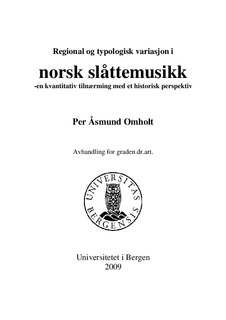| dc.description.abstract | The purpose of the dissertation is to shed light on regional and typological variations in Norwegian old-time fiddling in a historical perspective. I have analyzed 500 transcriptions of traditional tunes from different localities, limited to the gangar / halling and springar / pols varieties. With a computer program specifically developed for this task, I have adapted the tunes written in finger / scordatura notation for a statistical approach by digitalizing the notes. I focus on the role that differences in formal construction, tonality and rhythm might play in connection to the discussion about origin and historical processes. Concerning form, my investigation attempts to give an overview of the typological and geographical distribution of different types of motifs and different methods of formal progression. The determination of the motifs in the music is partly a matter of interpretation based on an inside perspective and personal, tacit knowledge. In order to study tonal matters, I relate the patterns of fingering to theories of scales, crucial tones, frames, modes and movement. My basic approach to the rhythmic aspects is to study the distribution of the note durations (1/4, 1/8, 1/16 etc.). The types of tunes in general or bar- or beat patterns in a rhythmical context are being related to the variation within these categories. My findings both support and add new aspects to the basic and well-known geographical division between the Hardanger fiddle repertoire and the repertoire of the ordinary violin. A polarity can be seen between: 1) a Hardanger fiddle gangar made up of small-motifs with a certain type of “chaining” in the melodic progression and the transposition of motifs in fifths vs. 2) a pols from northeast played on ordinary fiddle with the regular two-bar-form, longer motifs, systematic cadences and in which transposing is not so common. The frequency of finger placement also shows clear differences between the southern Hardanger fiddle districts and the rest. This division, however, does not concern the two types of instruments only. The border between the two areas reflects demographical processes mixed by impulses from outside as well as local innovation during the last centuries. I propose that the two areas be called the southwest and the northeast areas. I summarize typical features of the southwest area as a large repertoire of gangar, small-motif formal development with “chaining”-technique and transposition of motifs, frequent fingering on the D-string, descending tonal movement caused by falling thirds and an overall dominance of major tonality. In the northeast area, gangar / halling tunes are rarer and the regular two-part form dominates. The E-string is the most used string, transposition is not common in melodic progression and parts of the repertoire are in what we experience as minor. Concerning the historical aspect, I argue that the traditions in southwest may be the results of impulses during the 16th century. Dance, music and possibly early fiddle instruments may have spread to Norway through a strong contact to German speaking areas. This view corresponds with the core in the dance scientist’ hypothesis. According to my research, the gangar seems to be the archetype in this tradition. I describe a process of transformation of pols melodies in eastern Norway towards the typical formal patterns of southwest gangar. The eastern impulse is probably slightly younger than the south-western and has spread among different social layers, while the early southwest tradition probably spread among people from lower strata. Also, I speculate that the differences in the fingering patterns between southeast and northeast might be the reflection of a musical heritage carried on from older three-stringed fiddles in southwest. In some aspects, the material shows homogeneity regarding tonal structures. An investigation based on eleven different tunings makes it possible to describe a basic tonal frame consisting of the fifth below the tonic, the tonic, the second, the third and the fifth (5 – 1 – 2 – 3 – 5), with the major triad as a core. | |
